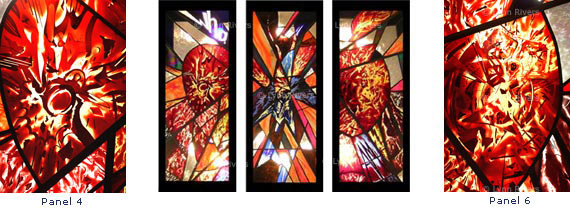
Story of Work: Lichtenstein & Wha AM!
The main feature (the exploding apple and planes) of Moment of Impact 9/11 was initiated during the evening of 9/11 and developed through two study pieces and on to the nine completed panels.
After watching the television for many hours, I went to my bedroom and sat in silence, my head full of images. I tried to distract my mind by thinking of words that could be used to describe the attacks. I flicked through a dictionary but found there was nothing adequate. Later, unpacking books from storage, I saw an old copy of the work of the American artist Roy Lichtenstein. There was no need to open it, his painting Whaam! (1962) hit me. By dividing it into two, it produced Wha and AM! – suggesting to me both the sound of a person falling from the Twin Towers that morning, and the sound of children crying for their dead parent/s the next morning.
No other words were as powerful, as succinct, and subsequent thoughts of referencing Lichtenstein’s planes bursting through a giant apple of flames into the Twin Towers had become fixed. I wasn’t yet conscious that I was going to make any art about 9/11, but this image was now fixed in my mind, like a still photograph.
The plane in the left half of an apple-shaped piece of glass I developed in reference to Whaam! It is based on the first news reports which speculated that there had been an accident with a light aircraft. The plane in the right half of the apple is a jumbo jet in which hijackers are fighting passengers and crew as it hits its target.

Later discussions about initial responses to the previous day’s events made me think critically about the way it had been mediated and confirmed that my perspective was that of a TV/media witness, as it was for millions of people. I distinctly recalled feeling frustrated that my view was limited to a single lens – the TV. Obviously there were many more cameras feeding more ‘live’ images into the newsrooms than one could see. I remember, after seeing a particular report, that I wanted to know where the camera crew went next? Were they alive? This happened again and again, fractured accounts feeding the overarching news story.
I wanted to do something, as is the common human reaction to disasters. Could my skills be of assistance? Did I really want to be in New York on 9/11 as a professional photographer? This was obviously hypothetical as it would become a site of criminal investigation that would exclude access. I had no previous inclination to go to other war zones, to record man’s inhumanity, nor did I seek the smell of burning buildings, bodies and hair or consume the pollution in New York.
I also remember being shocked by the newspaper photographs the next day, of people leaving the building via the stairwells, the blandness of the architecture and the desperation of what was taking place. When I looked at these images I recalled the momentary feeling of a lift descending at an uncontrollable speed, as in fact the towers fell down. The photographs also seemed ‘very’ still, encapsulating and more solid, the camera lens then seemed even more limited than the moving TV cameras that concerned me during 9/11 but it provided significant details. Subsequently photographs were more considered than watching the moving image and had a greater influence on this piece of work. What also stood out for me was no matter what was photographed, and undoubtedly there would be thousands of images made that day, there were some things that could not be photographed and/or couldn’t survive. (more...)
I had just started working with some glass when the planes struck the windows of Twin Towers. The windows where collagues once waved from one tower to the other, or enjoyed the views across the city, had become part of the killing device. How many were maimed by glass? How many people escaped the showers of shards? How much glass became molten and how many of the 50,000 windows used in the Twin Towers were turned to dust and a pollutant. This innocuous material became ugly. Tragically and ironically glass was a lethal and maiming component of the Twin Towers. Glass as a material was therefore obviously appropriate to making a piece of work about 9/11.
Glass is also a medium that can potentially endure for hundreds of years as the stained glass windows in Britain and elsewhere testify. It is far superior for retaining images than any photographic processes that I had pursued in archival work. I have worked with the finest of objects from the neolithic to the present day through my employment in museums; I now wanted to make something of that calibre.
- To find out how this initial work became nine panels of glass. (more...)
If you are interested to find out more, please contact the artist
Moment of Impact 9/11 is now seeking a permanent home contact us.